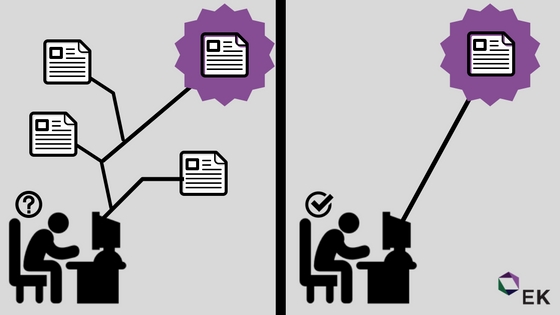Taxonomy is not as daunting as it seems. In this blog series, one of EK’s taxonomy experts, Ben White, provides 4 practical steps to designing and validating a user-centric taxonomy.
Step #1: Design a User-Centric Taxonomy
When most individuals hear the term “taxonomy design,” the initial reaction may be to disregard the practice as too technical or complex. Yet in reality, all that a taxonomy design entails is collecting the information that is already available, then organizing it to help your end users find and use the correct information efficiently and effectively. The end product—a taxonomy— is a standardized list of terms or controlled vocabulary, which can be applied to product categorization, web site structure, and faceted nav igation.
igation.
Regardless of the way you choose to use a taxonomy, it is important to understand the tried and true principles that allow us to design for success. At Enterprise Knowledge, we use traditional information science principles together with core usability concepts to enhance information retrieval in diverse information environments.
When searching for information, it is common for users to jump from page to page
or document to document. This allows users to discover more about the information they are seeking and as a result, refine their search. This behavior is known as “berrypicking”. The berrypicking model was developed by Marcia Bates at the University of California at Los Angeles. Berrypicking results in multiple searches before a user finds the appropriate set of information. However, when designing a taxonomy to aid in search retrieval, we should always strive to help users find information faster and limit berrypicking. This is a difficult task, as search behavior varies from user to user. Despite user differences, there are a number of key factors that influence the way users search for information. Some of these factors include:
- Technical Proficiency: How familiar users are with a specific subject area
- User Goals: What users are looking to achieve in the information environment
- Query Formulation: Terms used for searching
Technical Proficiency
Levels of subject knowledge and field proficiency within a group of users governs the language that users will use to search. Users with a great deal of knowledge and familiarity with a subject will use precise and industry specific jargon. On the other hand, users with less technical knowledge will use more general terms. It is important to keep this in mind when designing a taxonomy.
User Goals
It is important to uncover how users will interact with the information environment. Andrei Broder identified three prevailing goal-based query types when searching for information:
- Navigational Queries– Users searching to reach a specific area of an information environment. One example of a navigational query is a user searching to get to a specific portal or area of a website.
- Informational Queries– Users searching to acquire specific information in a web page or document. An example of an informational query would be a user searching for where Oolong tea originated.
- Transactional Queries– Users searching to perform a task. This could include submitting time and leave information.
Of course, there will be elements of each of these queries among users and we should design for all. However, there will most likely be one or two prevalent goal based query types. Being aware of these goals can create a more efficient taxonomy design.
Query Formulation
Examining the components of user queries by query analysis can help identify how users search. It is important to note any patterns that appear when analyzing user queries. Common patterns to take note of include:
- Acronyms
- Technical Jargon
- Query Length
- Noun based Queries
- Verb based Queries
The common patterns found when analyzing the queries should be reflected in the taxonomy. This will ensure that actual queries are echoed in the taxonomy, improving usability and findability among users.
By applying usability and information science concepts to the taxonomy design process, you can maximize the findability of your content. Designing a user-centric taxonomy is only the the first step. Stay tuned for future blogs to learn more the remaining steps in designing and validating an effective taxonomy:
- Make Sure Your Facets Are Consistent (Step 2)
- Validate Your Taxonomy (Step 3)
- Measure the Findability of Your Content (Step 4)
Can’t wait? Contact Enterprise Knowledge for help with enhancing the usability and findability of your information.
